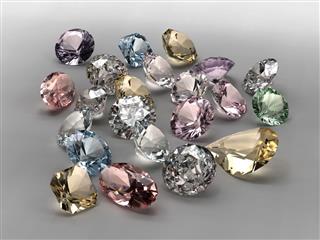
Don’t know which simulated diamond is best suited for you? Here’s a look into reviews of simulated diamonds to help you understand which one is the best of them all. Take a look.
Diamonds have been used to create exquisite pieces of jewelry for ages now. Over time, their beauty has only been enhanced, with the methods of using them in new and unique designs in different pieces of jewelry. This has made them more sought after especially by women. This demand, and the dangerous process by which diamonds are mined and then polished, make them extremely expensive and a real luxury that not many can afford. However, if you cannot imagine wearing diamonds, you can definitely look into wearing diamonds that have been recreated to match up to their real counterparts. In fact, simulated diamonds are even embraced by those who are against the dangerous mining process of natural diamonds.
The beauty and sparkle of natural diamonds can now be recreated with the variety of simulated diamonds that are now available for you to choose from. While owning a real diamond is something most of us only dream of, its simulated counterpart is definitely more affordable and is the best choice if wish to sport this wonderful, sparkling rock without having to pay the colossal prices for it.
An Introduction to Simulated Diamonds
Simulated diamonds are stones that mimic the appearance of real diamonds but do not possess the properties of real diamonds. At the most, they are capable of emulating these properties to a certain extent. However, they are developed in such a way that some appear absolutely perfect, as against natural diamonds that may be prone to certain flaws. The most important aspect to consider when you wish to compare simulated diamonds vs. real diamonds is the cost factor. The former allows you to sport the beauty of a real diamond without having to spend large amounts. Each of variety of simulated diamonds has its own pros and cons, but this doesn’t make them poor or cheap imitations. It ultimately depends on what you think suits you the best.
Reviews
To be able to understand which simulated diamond is best suited for you, it is essential that you compare it with the properties of a real diamond. Given below are the properties of natural diamonds, followed by those of the varieties of simulated diamonds.
| PROPERTIES OF A NATURAL DIAMOND | ||
| Refractive Index | 2.417 | Amount of light the diamond is able to absorb or the speed at which the light is absorbed. |
| Dispersion | 0.044 | The ability of the diamond to emit the light. |
| Hardness | 10 (highest) | Measured on the Mohs scale of mineral hardness that refers to the scratch resistance of the diamond. |
| Density | 3.25 g/cm3 | Strength of the diamond and the internal flaws it may be prone to. |
| PROPERTIES OF SIMULATED DIAMONDS | |||||
| Type | Refractive Index | Dispersion | Hardness | Density | Remarks |
| Glass Simulant | 1.6 | 0.020 and above | Less than 6 | 2.4-4.2 | Prone to scratches, trapped air bubbles show through the stone. |
| White Sapphire | 1.762-1.770 | 0.018 | 9 | 3.91 | Low brilliance when cut and polished. |
| Spinel | 1.727 | 0.020 | 8 | 3.6 | Low brilliance when cut and polished. |
| Synthetic Rutile | 2.62-2.9 | 0.33 | 6 | 4.25 | Has a slight yellow tinge. Can be created in different diamond colors. Looks brilliant as a diamond. |
| Strontium Titanate | 2.41 | 0.19 | 5.5 | 5.13 | Prone to scratches, visibility of trapped air bubbles through stone, joints (if any) are prominent. |
| YAG (Yttrium Aluminum Garnet) | 1.83 | 0.028 | 8.25 | 4.55-4.65 | Popular variety of simulated diamonds. Emulates a real diamond when cut and polished. Available in colored varieties. |
| Cubic Zirconia | 2.2 | 0.06 | 8.3 | 5.7 | Most popular and one of the best simulated diamonds. May be prone to scratches. |
| Moissanite | 2.648-2.691 | 0.104 | 8.5-9.25 | 3.2 | Another among the best lab-created diamonds. Looks real after polishing. May have some internal flaws. |
Several reviews suggest that the cubic zirconia (CZ) has emerged as a clear winner when it comes to being the highest quality simulated diamond. In fact, when you compare the properties of a cubic zirconia vs. a real diamond, you will find that the former has more sparkle and is far more brilliant, a property which is lacking in a natural diamond. Since real diamonds are naturally occurring, they are prone to a lot of flaws. On the other hand, artificial diamonds can be given a flawless shine that is missing from some varieties of natural diamonds. As such, simulated diamonds are definitely a more affordable and sparkling option versus real diamonds. Of course, a diamond is a diamond, and no one can undermine the exquisite properties of the real thing. However, it all boils down to affordability and how great it looks, whether real or simulated.














